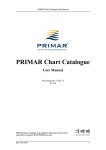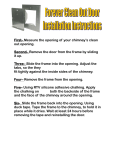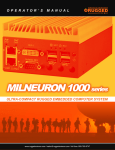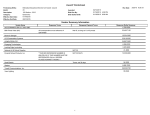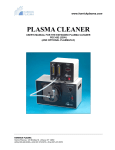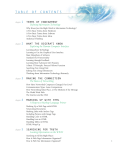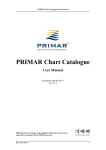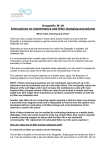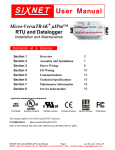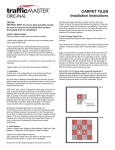Download 7 Steps To painting Your Pool Or deck
Transcript
VERY IMPORTANT*** THE FOLLOWING STEPS & PROCEDURES MUST BE FOLLOWED TO HAVE A SUCCESSFUL POOL PAINT APPLICATION SEVEN STEPS TO SUCCESSFUL SWIMMING POOL PAINTING CONTENTS INTRODUCTION SCHEDULING THE JOB SURFACE PREPERATION SELECTING SWIMMING POOL PAINT SECURING EQUIPMENT AND PREPARING TO PAINT STARTING TO APPLY POOL PAINT FIVE DRYING DAYS TO CURE SEASONAL SERVICING EXTENDS POOL LIFE TROUBLESHOOTING INTRODUCTION Consider for a moment the conditions a pool paint must endure - water, pressure, chemicals and sunlight. Consider the investment made in the painting of a pool cost of paint, cost of preparation materials and, most of all, cost of labor or time. The quality of paint is very important, but quality will not overcome the problems associated with pool application. It is absolutely essential to follow the steps outlined here, and to have responsible, conscientious personnel and/or supervision if NATIONAL POOL FINISHES are going to perform to the level expected of a quality product. Ownership of a swimming pool, new or old, requires a careful step-by-step program of recommended maintenance painting. The original investment is reason enough to practice preventive maintenance for pool protection and good service life. When you purchase swimming pool paint, you should get protection for the pool, beauty for the swimmers and spectators, and easy-to-maintain cleanliness. The following seven steps to successful pool painting are based on NATIONAL POOL FINISHES detailed research studies of pool painting practices and problems, both in the lab and at pool side. 1. SCHEDULING THE JOB Once you decide to paint your pool, when is the best time to do it? Either Spring or Fall is the best season. The idea is to avoid extremely cold or hot weather. In northern states, the best time for painting masonry pools is in the Spring or early Summer. Warm, dry weather is a must. Humid, moist air will retard paint drying and cause blistering and peeling. The warm temperature during the recommended seasons produces highly durable coatings with "breathing-type" water repellency. It is best to avoid painting after a rain or when the temperature is below 40o. Although a sudden shower will not wash away your day's efforts, after a rain wait until the walls dry out before painting again. Do not paint over frosted or rain-wet surfaces. It is best to paint when the weather is good for drying and you are not handicapped by dust, wind or annoying insects. Painting should be done only from midmorning, after the dew has evaporated, until mid-afternoon so that the paint will be relatively dry before the sun sets and dampness settles. In the case of new concrete pools at least two months should be allowed for aging before painting. The pool should be filled with water during that time to leach out any water-soluble salts held in the concrete. This will help to eliminate future reaction between alkalis and the paint. After draining the pool, let it dry for at least one to two weeks. Ask your local Weather Bureau for the five- to seven-day forecast. Work should not be started if rain or excessive humidity is predicted. 2. SURFACE PREPARATION One of the most important steps for success in painting your pool is preparation of the surface before painting. Most swimming pool paint failures occur because of inadequate surface preparation or pool paint application techniques. Correct surface preparation involves hard work and has no short cuts, or "miracle-primer" substitutes. All masonry surfaces must be perfectly clean and completely dry before any paint can be expected to perform well. All cracks, holes and surface breaks must be repaired with a rich grout or non-shrink patching mixture. Cracks over one-quarter inch should be filled with a cement mix by wetting down the area thoroughly before the cement mix is forced into the crevice. The cement mix should be two parts clean, hard, sharp sand to one part Portland cement... with enough water added to make a thick heavy mixture. The sand should not contain loam which promotes fungus growth. After filling all holes and cracks, sweep the pool thoroughly to remove all loose dust, using a heavy duty vacuum if possible. Almost every pool painting project will encounter one or both of the following conditions: (A) Bare concrete or plaster finish; (B) Previously painted surface. A. SURFACE TREATMENT OF BARE CONCRETE Unpainted concrete, new or old, is rarely ready to be painted as it stands. It is generally recommended that new concrete or masonry swimming pools age for at least two months before painting. The pool should be filled with water during this period to dissolve salts in the concrete. Plaster-lined pools require at least 30 days to cure. If grease, oil and dirt are present, remove with a strong cleaner such as TSP (TRI SODIM PHOSPHATE). Rinse the surface thoroughly to remove all residue after washing, and allow to dry before etching. All new concrete pools should be acid-etched with MURIATIC ACID. Dilute the solution 1 part acid to 4 parts water in a 5 gallon bucket, and use a scrub brush to apply to the pool surface. Etching cleans the concrete and prepares the surface to hold paint. It produces a micro-roughening of the masonry finish to make it more porous and to neutralize the alkali on the surface. The etching product should be applied to the concrete at a rate of one gallon per 200-500 square feet. Apply with a stiff brush or sprayer and permit the solution to stand for at least 15 minutes, or until the surface stops foaming and bubbling. Then, hose down several times with plenty of water to be sure that no contaminating materials remain. NOTE: It is extremely important to remove all the acid from the surface, or the paint will not adhere well. The surface should dry thoroughly before painting. Protect your hands, feet and eyes from the acid product with rubber gloves, boots and goggles. B. SURFACE TREATMENT OF PREVIOUSLY PAINTED POOLS Before repainting your pool remove paint not in good condition, i.e., paint that is flaking, blistering, cracking or chalking heavily. A major cause of pool repainting failures is allowing too many old coats to build up. It is generally advisable to completely remove all paint on the pool every three to four seasons, or after four coats of paint are on the pool. Too many coats of paint left on the pool will result in poor durability of subsequent coats. It is especially important to remove all paint if cracking or "alligatoring" of the paint has occurred. Otherwise, the action of water pressure on the cracks, even if they are very small, will cause lifting of the paint. The old paint must be completely scraped and brushed off with a wire brush, by sandblasting, or a paint stripper. Thoroughly remove any residual stripper. The pool then must be scrubbed as clean as possible to remove grease and dirt, using hot water and TSP. Rinse off all cleaners completely, or poor paint bonding will result. Old paint in good condition will show strong adhesion and uniform chalking. Such surfaces may be painted without further treatment. All bare and patched areas should be acid-etched by using the same methods as for bare concrete discussed previously. After etching, the pool should be scrubbed and flushed clean with water. Again, it is extremely important that all acid be neutralized and removed. Failure to properly neutralize and remove acid is the single most common cause of pool painting failures using the acid-etching procedure. Only thorough rinsing with water will achieve this purpose. Then allow surface to dry completely before painting. Acid etching is not required on areas where the paint is in good condition, or if the pool has been sandblasted. 3. SELECTING SWIMMING POOL PAINT The main purpose of a swimming pool finish is to produce a watertight coating that is durable and adds beauty. A properly formulated paint assures adequate protection and good service life: resistance to water, alkali and chemicals; durability; good adhesion to concrete and previously painted surfaces. The right paint saves you money and time. NATIONAL POOL FINISHES are recommended because it forms a tough, durable and chemically resistant film. Pool Guard EHB & POOL GUARD, our 2part epoxies, Pool Shield CRX / POOL SHIELD, our chlorinated rubber products, and AQUA KOTE, our acrylic waterbase pool paint, are customer-preferred coating on pools in all parts of the country for both indoor and outdoor swimming pools. After the paint has dried, the pigment (color portion of the paint) and binders remain--all other ingredients evaporate. The binders hold the pigment and safeguard the surface by forming a protective film. PROPERTIES NATIONAL POOL FINISHES POSSESSES TO OVERCOME POOL PROBLEMS ALKALI RESISTANCE: Cement surfaces are, by nature, alkaline. These alkalis, which come from the lime in cement manufacture, are caustic and cause corrosion. They can attack and destroy paint films. NATIONAL POOL FINISHES provides coatings that are alkali-resistant to a high degree. MOISTURE PROOF: The moisture problem is twofold--the applied paint film must be relatively impervious to water and, at the same time, should be capable of "breathing" to allow moisture to escape from the sub-surface of the masonry. Without this ability, moisture drawn into the concrete surface combines with the alkali and results in corrosion between the sub-surface and the paint coating. NATIONAL POOL FINISHES permits moisture to escape from the pool wall through the paint without blistering or peeling, and without losing its ability for water resistance. ULTRAVIOLET LIGHT RESISTANCE: Pool surfaces are subject to extreme amounts of sunlight, which is intensified by the water. Ultraviolet light tends to degrade paint. But, NATIONAL POOL FINISHES provides excellent resistance to sunlight. CHEMICAL AND MILDEW RESISTANCE: A predominate requirement for pool paint is chemical inertness. NATIONAL POOL FINISHES is not deteriorated by the chemicals used in pools or by mold or fungus. NATIONAL POOL FINISHES will not support the growth of micro-organisms such as algae. This helps to eliminate slick and slimy pool walls and floor. You get greater safety and a cleaner pool. Of course, Swimming Pool Algaecide should be used to combat algae. SPECIFIC ADHESION: This is important for both new and old pools. NATIONAL POOL FINISHES adheres firmly to new or previously painted surfaces. It does not require the use of special primers--either on painted or new surfaces. However, there are certain paints, such as epoxies, that require special precautions. Epoxy paints exhibit an extremely hard and highly chalked surface. Therefore, epoxy paints should be removed or at least thoroughly roughened by sandblasting before application of NATIONAL POOL FINISHES . QUICK DRYING ABILITY: Swimming pool paints often dry-to-touch in less than one hour with minimum dirt pickup. For effective performance and maximum water and chemical resistance, it is recommended that a minimum of overnight dry elapse between coats, and that a minimum period of five to seven days elapse after the final coat application and the filling of the pool. Weather conditions might dictate even longer waiting periods. STAIN, SCRATCH AND FADE RESISTANCE: This is a must in good swimming pool paints. NATIONAL POOL FINISHES has excellent resistance to abrasion, staining and discoloration. The paint develops strong, mechanical strength within itself. This tough film holds the color pigments firmly and assures long color retention a well as stain and abrasion resistance. NON-SKINNING, NON-THICKENING: NATIONAL POOL FINISHES prevents skinning-over or increased viscosity due to aging. Stability and good life in the pail are two proven features of our pool paint products. 4. SECURING EQUIPMENT AND PREPARING TO PAINT A. SUGGESTED EQUIPMENT NATIONAL POOL FINISHES can be applied by brush alone, or with a roller. For ordinary painting, a brush 3 1/2 to 4-1/2 inches wide will do fine. A long bristle brush is preferred by experienced painters because of its spring and extra paint carrying capacity. A relatively smooth, dense masonry surface can be painted with a roller, if you wish. Carefully clean your painting shoes before starting to paint. No shoes with nails should be worn in the pool. Sneakers or rubbers are preferred. B. HOW MUCH PAINT? A very common cause of pool repainting failures is not applying a heavy enough coat of paint. It is very important that a sufficiently thick coat of paint be applied. A thin coat will have poor durability and necessitate more frequent painting. A goal should be to obtain coverage of about 250 - 300 square feet per gallon. The amount of paint you will need depends upon the surface to be painted, its area, porosity, texture, relative condition and number of coats required, but average coverage should be about 250 - 300 square feet per gallon. NATIONAL POOL FINISHES does not require a primer and does not depend upon deep penetration, or an overly thick coating to give good service life. Remember that a gallon of paint is a measured quantity. Coverage depends only upon the penetration and thickness of the coat. To estimate the amount of paint needed, first calculate the square feet of paintable area. Next, from your knowledge of the condition of the surface, determine its porosity and texture, estimate the square feet one gallon will cover. Finally, estimate the number of coats. The amount of paint needed is found by multiplying the square feet of paintable area by the number of coats and dividing by the square feet one gallon will cover. Approximate examples of first coat coverage are: Smooth, dense surface: 250-300 square feet Porous, rough surface: 200-250 square feet The second coat usually covers approximately 300 square feet. C. HOW TO MIX THE PAINT The first coat on bare concrete penetrates and fills surface voids to provide a good base for the final coat. On previously painted surfaces, the first coat aids in binding and wetting the normal chalking of the weathered paint. It forms a strong base for the finish coat. Thorough mixing is critical for proper pigment dispersal. Extra mixing may be required if the paint has set for some time. To mix, pour off most of the paint into another pail. Stir that remaining in the bottom of the pail, and gradually pour back the rest of the paint as the stirring progresses. Stirring helps make the color and composition uniform. Finally, pour the paint back and forth from one container to another several times. This is called "boxing" the paint. The smooth, even paint is now ready to be applied. 5. STARTING TO APPLY POOL PAINT A. USING THE PAINT If it is extremely warm you will find it more comfortable to paint the east and south sides of the pool in the morning hours, the west and north sides in the afternoon. With this method, the walls of the pool allow you to paint in the shade. The paint will dry rapidly enough and be easier to apply. The corner of the pool is a good place to start. Begin at the top and work down from left to right so that the danger of running or dripping over a newly painted area is avoided. Running paint is an indication that the brush is being overloaded. Whether you follow the sun or finish one side at a time, try to finish the work at a corner of the pool to avoid laps or lines. By ending in the corner, where you leave off and begin will not be noticeable even if several days elapse before you return to finish. B. PRE- AND POST-PAINTING TIPS Save leftover quantities of paint; a small amount is often all that is required for touch-up work later. Searching for a particular color can be simplified by putting a dab of paint on the pail lid before storing. Use the following information when applying the paint with a sprayer. If thinning, never use over one pint of thinner per gallon of paint: SPRAYING DATA Conventional Airless Reduction Xylene None Spray Gun Graco 204-275, DeVilbiss JGA-502 or equal Graco or equal Caps and/or Tips Graco 161-191 (161189), DeVilbiss 491D or equal 0.017 to 0.125 Atomization Pressure 50 to 60 psi -- Fluid Pressure 15 to 20 psi 2,000 to 3,000 psi 6. FIVE DRYING DAYS TO CURE The first coat penetrates and fills surface voids to give the finish coat strong adhesion. Following each application it is suggested that a minimum drying time of five days be allowed to assure complete solvent evaporation and film hardening. To attain maximum water resistance after the second coat has been applied, five days should elapse prior to filling the pool. The paint may be dry on the surface, but if you fill the pool too soon you can encourage blistering and peeling. Again, weather conditions might dictate even longer drying times. 7. SEASONAL SERVICING EXTENDS POOL LIFE Now is the time to plan your maintenance program just as carefully as you select your pool paint. Your swimming pleasure can be spoiled by incorrect or incomplete maintenance after you paint. Follow these simple rules of maintenance and use NATIONAL POOL FINISHES to obtain the best possible service life from your pool. Keep your pool clean with Pool Algaecide which prevents algae and hazardous slime on the surface of the floor and walls. At least at the beginning of the swimming season and at the end, the pool should be thoroughly scrubbed down. All cracks must be patched and sealed with paint to eliminate any moisture buildup under the coated surface. Good service life -- particularly winter-survival of the surface coating -- is only as good as the pool design and construction. The basin must be watertight to prevent hydraulic lifting of the paint. A bituminous outer coating or plastic interlayer is fairly standard in modern pool construction. Soil drainage around the pool serves the same end. When a pool is drained the water-saturated masonry will release moisture through the paint film for some time until the moisture in the concrete balances with the atmosphere. When refilling the pool, the process is reversed. These alternating wet and dry conditions are rough treatment for any surface coating and may result in loss of adhesion and damage to the paint. While it may be helpful to keep water in the pool at all times, it is not a common practice and not an absolute necessity if the paint has been maintained as directed. It may be advisable to check with the builder of the pool to determine if the pool walls themselves can withstand freeze/thaw conditions of the surrounding ground without damage if the pool is drained over winter. If water is left in pool over winter months, poles or logs should be placed in the water to act as expansion points, as this will likely eliminate damage to the pool. Ownership of a swimming pool is an investment that should be preserved. NATIONAL POOL FINISHES features the proper formulation for maximum protection and easy-care maintenance. NATIONAL POOL FINISHES gives you these benefits: ° Applies easily with brush, roller or sprayer ° Dries quickly ° Alkali and chemical resistant ° Stays cleaner longer ° Easily covers new and old surfaces ° Resists growth of algae ° Breathing-type water repellency ° Good adhesion ° No primers required TROUBLESHOOTING BLUSHING - FADING - CHALKING The cause: The pool is filled too soon (before five days) before the paint is completely dry, causing a blush over the surface which looks like fading or chalking. Super-chlorinated water may cause a "bleached-out" look. The "shock" of calcium hypochlorite can cause a white, bleached look to the paint film, leaving a whitish deposit. Iron in the water from rust in the filter system may leave deposits and stain the film. The solution: Scrub surface using a solution of soap and water. This will remove surface dirt and deposits. Wet with a weak (2-3%) solution of muriatic acid. Acid will remove iron stains without damaging the paint film. Solvent wipe affected areas with solvent thinner. Check your pool water chemistry daily or weekly for: 1. Calcium hardness 2. Total alkalinity 3. pH Extremely corrosive water can ultimately cause deterioration or breakdown of a paint film over a period of years. Be sure the newly-painted pool surface dries at least five dry, sunny days before filling. BLISTERING The cause: Applying paint too heavily Painting a damp surface Filling the pool too soon Incompatible paints The solution: Apply at recommended coverage rates. Thicker is not better in the case of chlorinated rubber pool paints. All paintable surfaces must be dry prior to painting with chlorinated rubber. Wait at least 5 dry, sunny days prior to filling pool. DISCLAIMER: National Paint Industries manufactures quality products. This technical bulletin, data sheets & the product label have all information needed. By purchasing this product the customer accepts this information and waives all claims to any remedy arising from any guarantee of quality, whether such guarantee of quality was made expressly to the customer or implied by any applicable law. In no event will National Paint Industries be liable in any way for product failure. 1999 Elizabeth Street, North Brunswick, NJ 08902 – 800-432-4333 – 732-821-8180 FAX












